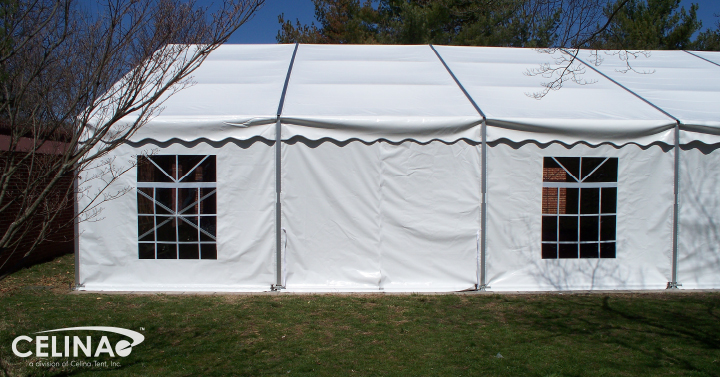Keder Track Fabrics for Tent Installations

Advancing in Tent Fabrics: The Keder Track
Many of the options offered at Celina Tent, Inc. are meant specifically for tent rental companies, in so much as they start to get into more advanced functions of the tent install trade. This is why when we start to go into more niche tent systems, we start to get more and more questions, such as “What, exactly, is that?” or “How do you pronounce that word?”. Today we’ll be covering one of the more interesting tent fabric installation styles that we offer: Keder.
The What
Keder, pronounced “key-dur”, is a solid line of flexible rubber that is attached to the edges of fabric panels. Each line has a circular profile and is wrapped in nylon that is welded onto the panels of tent top or sidewalls. These flaps on the keder line wrap around to both sides of the fabric panel to ensure that the welding processes creates a strong bond, since a lot of the tension that will be placed on the fabric while it is installed will be placed on these keder welds. Keder lines run for the entire length of the panels, on both sides.
Installing any kind of fabric with keder lines attached to it requires that the tent has the channels or track to accept it. Keder track is a C-shaped groove that is incorporated into the frame hardware that supports the tent. In most cases this track is part of the metal extrusion, eliminating the need to weld the track in place and create an additional failure point for the assembly.
The How
Most installations using keder track require rope tie off locations on the fabric in order to pull it along the track for installation. In the case of sidewalls, however, the tracks are short enough to be installed by hand.
Installations requires the keder track to have an entry location, or flared portion of the track that is wide enough for the keder line to enter. The ends of the fabric panel are fed into the track at this opening, which is normally located at either waist- or shoulder-height along the frame hardware. It’s important that both sides of the panel, be it a wall or top fabric, are fed at the same time and pulled at the same pace. This allows for the least amount of tension across the fabric. Once the bulk of the fabric has been led through the tracing across the frame, the final end of the panel is lifted to the flared section and fed in the opposite direction, finishing off the installation with all keder within the proper track.
In some instances, including military or humanitarian shelters that span much larger areas, a piece called a “keder leader” can be used. This is a small piece of keder with a tie off location and reinforced webbing that is more flexible than the entire panel, allowing it to run through the keder track first and help to feed in the rest of the keder line. This helps with shelter frames where the eaves or peaks have a significant bend or angle that may be difficult for the full panel to travel through when mixed with the side-to-side tension pulled across the fabric itself.
Celina works hard to remain at the forefront of the shelter and tent rental industries. From our lines of fabric shelters in Pole and Frame systems to our innovative tent printing processes, we can be your first and final stop in making sure your event is the best that it can be! Contact us at 866-438-8368 and let one of our Customer Account Managers help you choose the right shelter for you!
